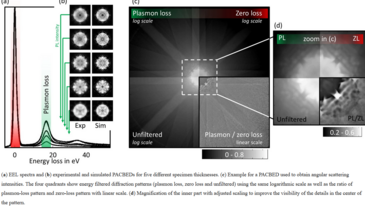A. Beyer, F.F. Krause, H.L. Robert, S. Firoozabadi, T. Grieb, P. Kükelhan, D. Heimes, M. Schowalter, K. Müller-Caspary, A. Rosenauer, K. Volz
Scientific Reports (2020) 10 (1), art. no. 17890
doi: 10.1038/s41598-020-74434-w
Scanning transmission electron microscopy (STEM) allows to gain quantitative information on the atomic-scale structure and composition of materials, satisfying one of todays major needs in the development of novel nanoscale devices. The aim of this study is to quantify the impact of inelastic, i.e. plasmon excitations (PE), on the angular dependence of STEM intensities and answer the question whether these excitations are responsible for a drastic mismatch between experiments and contemporary image simulations observed at scattering angles below ∼ 40 mrad. For the two materials silicon and platinum, the angular dependencies of elastic and inelastic scattering are investigated. We utilize energy filtering in two complementary microscopes, which are representative for the systems used for quantitative STEM, to form position-averaged diffraction patterns as well as atomically resolved 4D STEM data sets for different energy ranges. The resulting five-dimensional data are used to elucidate the distinct features in real and momentum space for different energy losses. We find different angular distributions for the elastic and inelastic scattering, resulting in an increased low-angle intensity (∼ 10–40 mrad). The ratio of inelastic/elastic scattering increases with rising sample thickness, while the general shape of the angular dependency is maintained. Moreover, the ratio increases with the distance to an atomic column in the low-angle regime. Since PE are usually neglected in image simulations, consequently the experimental intensity is underestimated at these angles, which especially affects bright field or low-angle annular dark field imaging. The high-angle regime, however, is unaffected. In addition, we find negligible impact of inelastic scattering on first-moment imaging in momentum-resolved STEM, which is important for STEM techniques to measure internal electric fields in functional nanostructures. To resolve the discrepancies between experiment and simulation, we present an adopted simulation scheme including PE. This study highlights the necessity to take into account PE to achieve quantitative agreement between simulation and experiment. Besides solving the fundamental question of missing physics in established simulations, this finally allows for the quantitative evaluation of low-angle scattering, which contains valuable information about the material investigated.
Influence of plasmon excitations on atomic-resolution quantitative 4D scanning transmission electron
microscopy


